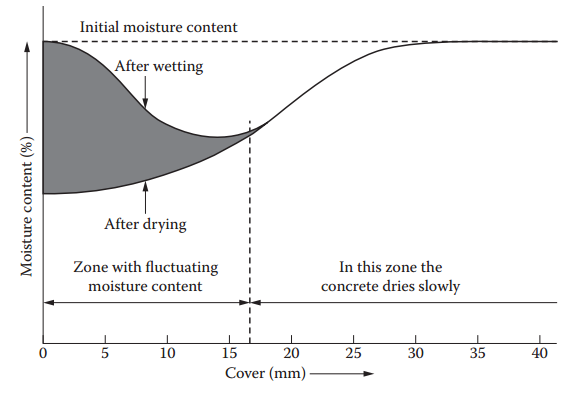For concrete structures in chloride-containing environments, the ingress of chlorides can take place in different ways.
Through uncracked concrete, the ingress mainly takes place by capillary absorption and diffusion. When a relatively dry concrete is exposed to saltwater, the concrete may suck the saltwater relatively fast, and intermittent wetting and drying may successively accumulate high concentrations of salt in the concrete.
For concrete structures in marine environments, intermittent exposure to splashing of seawater may also give fluctuating moisture contents in the outer layer of the concrete, as typically shown in Figure 1.

For many of the concrete structures along the coastline, however, constantly high moisture contents in the outer layer of the concrete were observed; for some of the concrete coastal bridges the degree of capillary saturation typically varied from 80 to 90% in the outer 40 to 50 mm of the concrete. Thus, for the thickness of concrete cover typically specified for concrete structures in severe environments, the moisture content in the concrete cover may be quite high, and hence diffusion appears to be a most dominating transport mechanism for the ingress of chlorides.
The ingress of chlorides into concrete is a very complex and difficult issue. Even pure diffusion of chloride ions into concrete is a very complex transport process. Therefore, when Fick’s second law of diffusion is often applied for calculating the rates of chloride ingress into concrete, it should be noted that such a calculation is based on a number of assumptions and a very rough simplification of the real transport mechanism.
For a proper assessment of the resistance of concrete to chloride ingress, a number of factors have to be considered:
- Generally, the water/cement ratio of the concrete is a most important controlling factor. In order to get
a proper resistance of concrete based on pure portland cements, the water/ cement ratio should not exceed a level of 0.40; - Incorporation of various types of supplementary reduces the chloride diffusivity significantly.
- By combining blast furnace slag cements with various types of pozzolanic material at very low water/binder ratios, very low chloride diffusivities can be obtained, and hence concretes with a very high resistance to chloride ingress can be produced.
